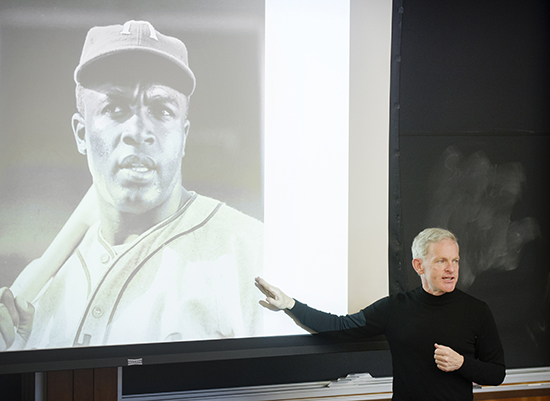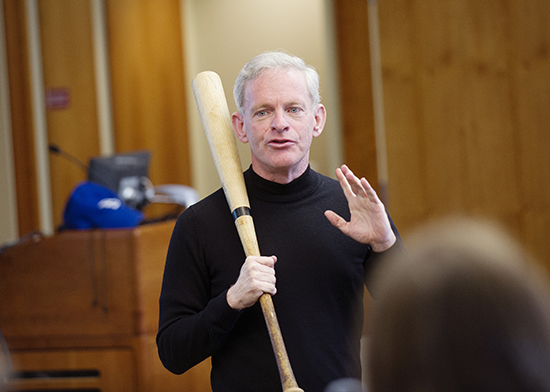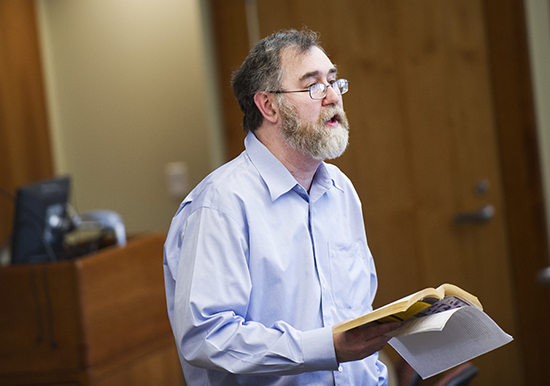What We Learn by Learning about Baseball
A triple play of America’s pastime by CGS faculty

In the CGS History, Literature, Film, and Science of Baseball class, Thomas Whalen talks about the historic moment when Jackie Robinson integrated the major leagues. Photos by Jackie Ricciardi
Class by class, lecture by lecture, question asked by question answered, an education is built. This is one of a series of visits to one class, on one day, in search of those building blocks at BU.
One after another, the three CGS faculty step up to the plate and take a swing…at the Boston Red Sox.
On this Thursday afternoon, there are a few Red Sox caps among the dozen students in The History, Literature, Film, and Science of Baseball: An Interdisciplinary Course. And Thomas Whalen, a College of General Studies associate professor of social sciences, Christopher Fahy, a CGS lecturer in humanities, and Andy Andres, a CGS senior lecturer in natural sciences and mathematics, don’t hesitate to teach a few facts that are less than flattering to the hometown team.
Up first is Whalen, who explains, for example, that the Red Sox were the last major league team to integrate, in 1959, more than a decade after Jackie Robinson took the field for the Brooklyn Dodgers. The Boston team passed on Robinson and on Willie Mays, indicating that talent wasn’t their sole criterion.
Whalen, who is writing a book about the 1967 “Impossible Dream” Red Sox pennant race, discusses the African Americans returning from fighting for freedom in World War II who were no longer willing to live without their basic rights at home. “You see baseball and the national culture combining as one here,” he says. He explains that Brooklyn Dodgers executive Branch Rickey chose Robinson to break the baseball color barrier in 1947 less because of his baseball skills than his impeccable character—Rickey wanted a man who would be strong enough not to fight back against racist threats and abuse.

“I wasn’t aware of how much of an influence baseball has had on American history,” class member Alexis Fahrney (CAS’18) says later. “The phrase America’s favorite pastime has come to be a lot more complicated than playing catch and eating Cracker Jacks.”
Baseball “opens a window up to American society as a whole,” Whalen says in an interview with the three teachers after class. “To put it bluntly, baseball is America, and America is baseball.”
The course was organized by the American and New England Studies Program as one of its capstone courses for American studies majors, as well as other interested BU students, and an example of the kind of interdisciplinary teaching that is part of the program’s mission.
“My favorite thing about the course is when Professor Whalen mentions Jackie Robinson’s tryout at Fenway Park or Babe Ruth’s final days at Braves Field, ” says Thomas Pelkey (CGS’13, CAS’15). “You realize that this history took place mere steps outside the classroom door. The meaning of hallowed ground really sinks in.”
The three faculty came together to teach the class largely “because no one else has done it before,” says Andres. “This is the first interdisciplinary course on baseball I’ve ever seen.” They hope to teach it again in spring 2016.
Also, Fahy says with a smile, “it’s fun to talk about baseball.”
“We use the game as the hook to get students to take a real hard look at the scholarship of literature and film, using baseball,” says Andres. “To take a real hard look at history using baseball. And a real hard look at science.”
Batting second in the class, Fahy reads aloud short passages from Veracruz Blues, a fact-based novel about a 1946 attempt to start a third major league in Mexico. That opens up a discussion on issues of race and self-determination (among the players) and money and class (among the teams). And that leads to thoughts about the ways that enormous wealth and payroll make the New York Yankees one of the most widely despised teams in the country.

Given their payroll, “I would put in the Red Sox as being deserving of some of that hate too, at least since the beginning of the century,” Fahy says cheerfully.
The class reading list includes some familiar choices, from nonfiction like Jim Bouton’s Ball Four and Michael Lewis’ Moneyball to novels such as Bernard Malamud’s The Natural and W. P. Kinsella’s Shoeless Joe.
There are also required movies, among them Bull Durham, Field of Dreams, Bang the Drum Slowly, and The Natural. But the cinematic highlight on this day comes when Andres, a specialist in sabermetrics (data-driven game analysis) and the physical science of the game, steps to the podium. He’s going to show in some detail why a pitcher scuffing up the baseball can get more movement on his pitch. Baseball in hand, he’ll explain concepts like drag vector and wake deflection force.
Andres first asks if everyone has seen or heard about a recent spring training incident where Mike Napoli of the Red Sox hit a towering home run despite breaking his bat. “He crushed the ball,” Andres says, but adds that you shouldn’t believe the commentators who were quick to describe this as a Herculean feat.
“This is 1,500 frames per second,” he says, introducing a video of a broken-bat contact by Miguel Cabrera of the Tigers during the 2012 World Series. Clicking back and forth through a handful of frames, he shows the ball hitting the bat, which bends on impact, then shooting back in the direction it came from. The ball is already several inches away when the shockwave resulting from the impact shatters the bat. So it’s likely that Napoli’s home run was already hit—its flight already set—before the bat broke. So not so Herculean after all—just another home run.
Like most iconic American stories, the students learn, those about baseball could use some careful vetting.
“The great myth is that the game itself was created in some cow field in Cooperstown, N.Y., a rural setting, by Abner Doubleday,” Whalen says. “But it was really a city game from the very beginning, and it captured the imagination of not just people who had money, who had leisure time, but also the growing immigrant masses. It was a game everyone could play. And it spread like wildfire.”
This Series
Also in
One Class, One Day
-
November 30, 2018
Breaking Bad Director Gives CAS Class the Inside Dope
-
October 31, 2018
Trump and the Press: We’ve Been Here Before
-
August 3, 2018
A Scholarly Take on Superheroes


Comments & Discussion
Boston University moderates comments to facilitate an informed, substantive, civil conversation. Abusive, profane, self-promotional, misleading, incoherent or off-topic comments will be rejected. Moderators are staffed during regular business hours (EST) and can only accept comments written in English. Statistics or facts must include a citation or a link to the citation.